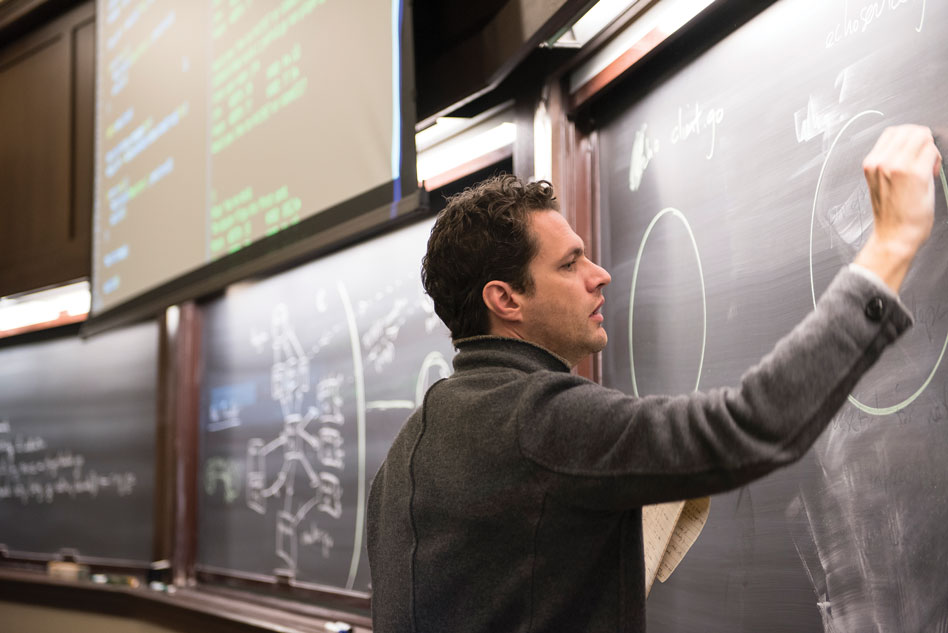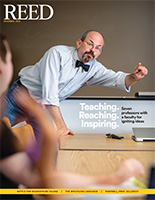
IRIS login | Reed College home Volume 95, No. 4: December 2016
Inspiring Professors (continued)

“Liberal arts schools like Reed produce computer science majors who can write, think, and communicate. And they also have great technical chops.” Photo by Nina Johnson ’99
Jim Fix [computer science 1999–] Crandall Chair
By Romel Hernandez
The Richard E. Crandall Professorship in Computer Science honors the rich intellectual legacy of the late Richard Crandall ’69, longtime physics and computer science professor [1978–2012].
Scratching an Itch: Prof. Fix was the first tenure-track computer scientist ever hired at Reed, which gave him the opportunity to build a program from scratch. It took some time, but in 2017 the college will launch a full-blown computer science program, thanks to donors who contributed $5 million to support it.
“Reed gave us a chance, and I feel really good about the courses, the curriculum, the people we’ve hired,” he says. “Computer science can be really rigorous, and it doesn’t need to be about training students to write software to get a job. This program is about algorithms and mathematical thinking about the limits of computing and computation.”
In a Nutshell: Fix grew up in Pittsburgh and attended Carnegie Mellon University, majoring in math and computer science. As an undergraduate he was interested in scientific computing. He sought internships at Westinghouse Electric, where he worked on code for full-scale nuclear reactor simulators, and at Lawrence Livermore (LLNL), where he worked on code for seismic tomography and signal recognition. He also taught for several years as part of CMU’s introductory programming group. LLNL’s supercomputers made him deeply curious about the theory of parallel algorithms, and he pursued that research for his PhD at the University of Washington. Ultimately, his love of teaching computer science led him into a career in academia. Since arriving at Reed in 1999, he has focused much of his energy on starting the computer science program. Currently the program has three professors, one housed in biology. A fourth is joining Reed next year. Before the expansion Fix shouldered the curriculum, teaching courses on subjects ranging from computer hardware to computational complexity. He has managed to keep pace with advances in his field, and now that the computer science program is established, he is looking forward to spending more time on his own research.
Apples and Algorithms: When he was a kid back in the 1980s, Jim wrote a program in BASIC on a cousin’s Apple II and was thrilled when, at the age of 12, he received a Commodore 64 home computer as a present. Computer technology has evolved more than a byte since those days. Today Fix explores the vast possibilities of parallel computing, which involves the coordinated use of supercomputers to solve massive computational problems. He explores the theoretical side of computation, designing and analyzing algorithms that support parallelization.
Doing the Math: Some people questioned whether computer science was a good fit at Reed, but Fix answered skeptics by developing a rigorous, math-focused program with a strong emphasis on theory whose courses have proven popular. He notes that the number of students taking the introductory computer science class has grown to about 120.
“Really, computer science and the liberal arts are a perfect combination,” Fix says. “We’ve reinvented the way computer science is taught.”

LATEST COMMENTS
steve-jobs-1976 I knew Steve Jobs when he was on the second floor of Quincy. (Fall...
Utnapishtim - 2 weeks ago
Prof. Mason Drukman [political science 1964–70] This is gold, pure gold. God bless, Prof. Drukman.
puredog - 1 month ago
virginia-davis-1965 Such a good friend & compatriot in the day of Satyricon...
czarchasm - 4 months ago
John Peara Baba 1990 John died of a broken heart from losing his mom and then his...
kodachrome - 7 months ago
Carol Sawyer 1962 Who wrote this obit? I'm writing something about Carol Sawyer...
MsLaurie Pepper - 8 months ago
William W. Wissman MAT 1969 ...and THREE sisters. Sabra, the oldest, Mary, the middle, and...
riclf - 10 months ago